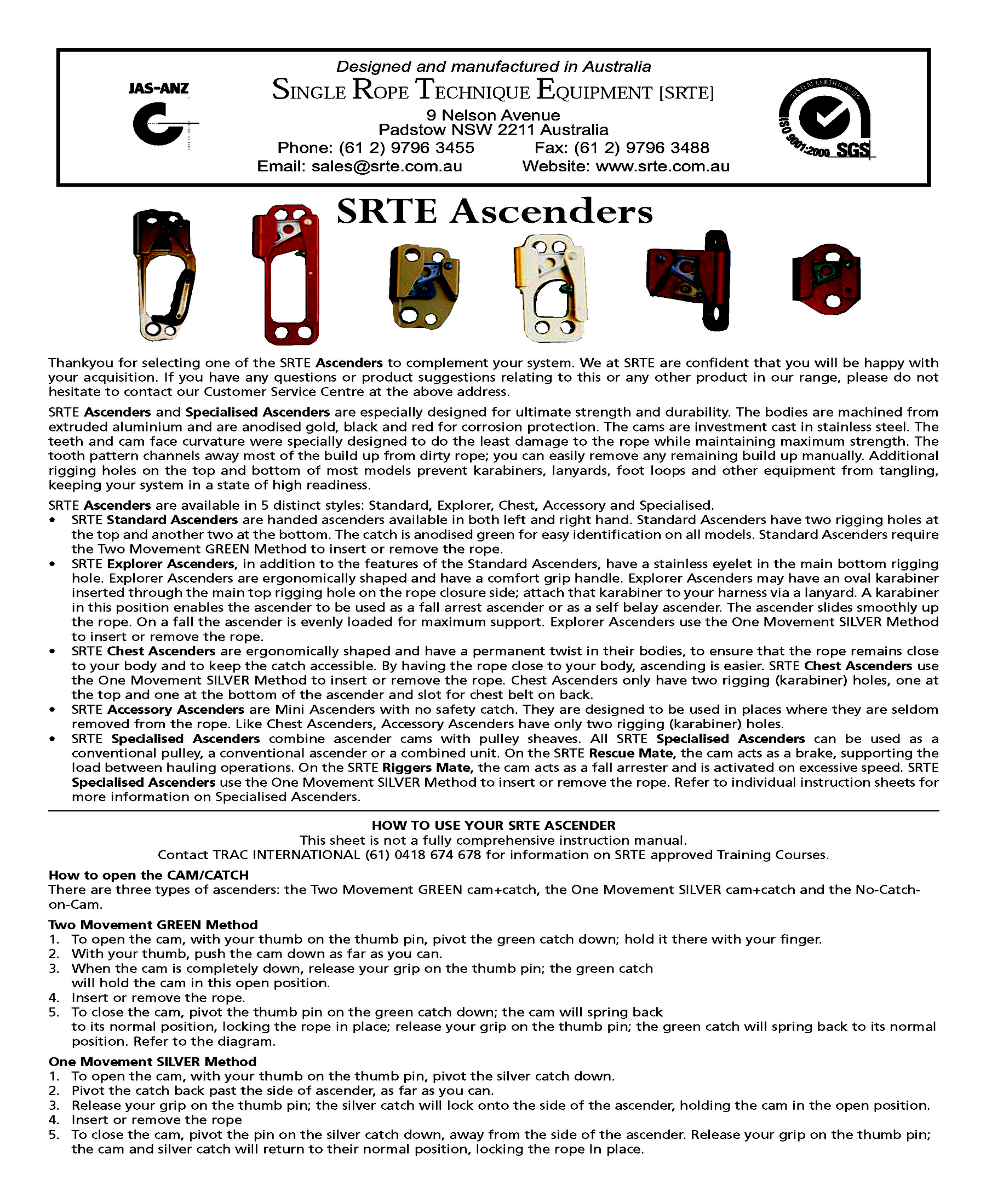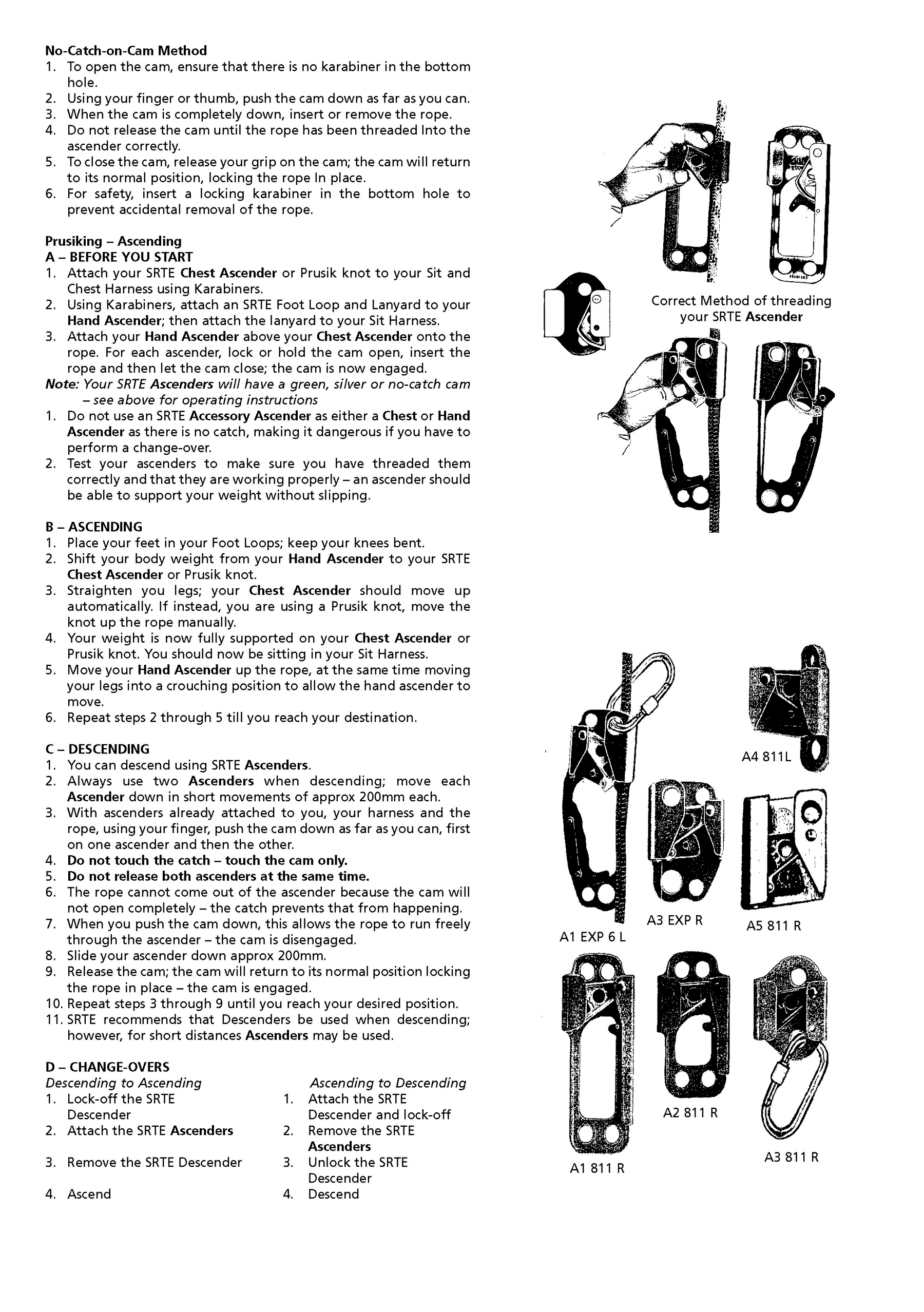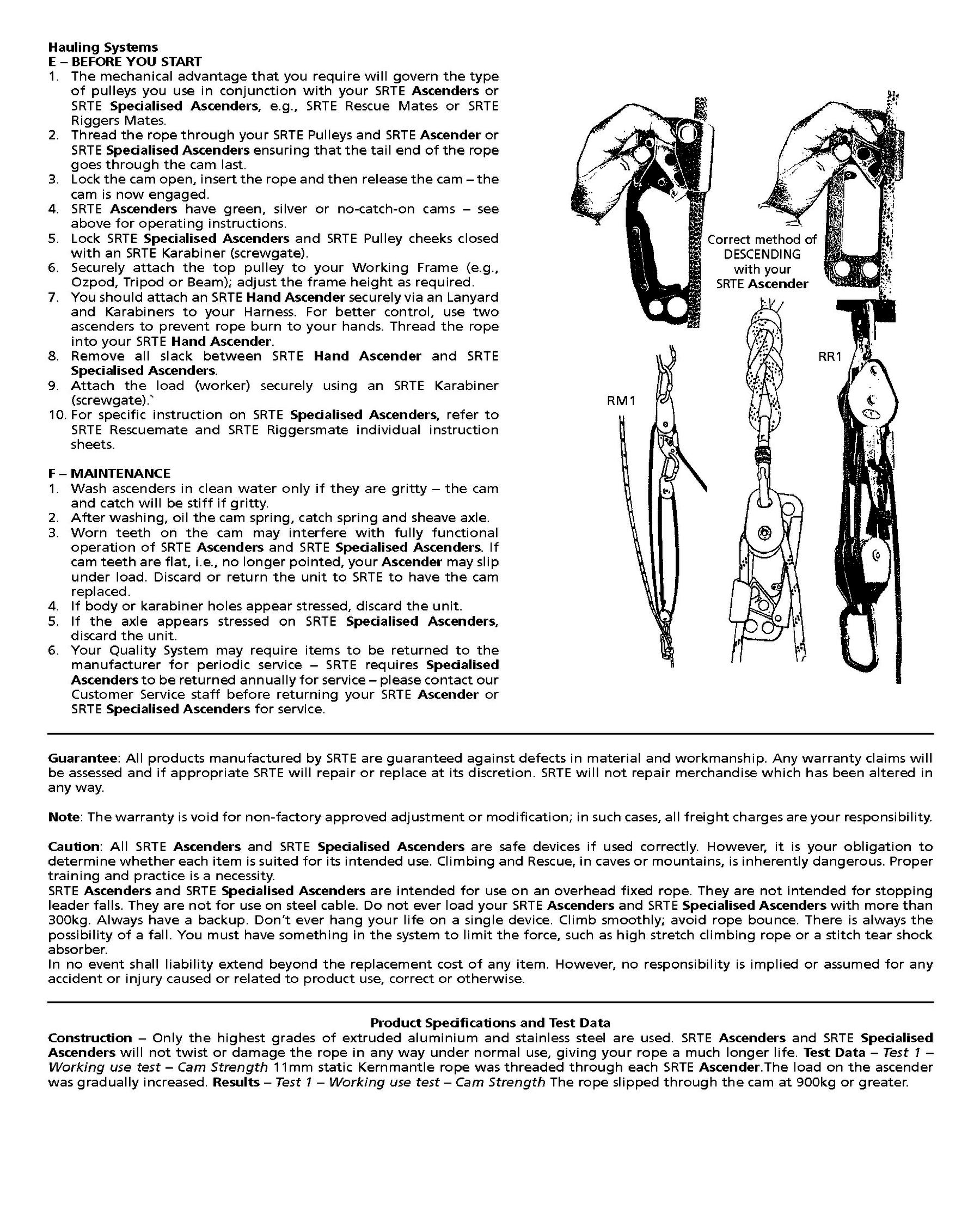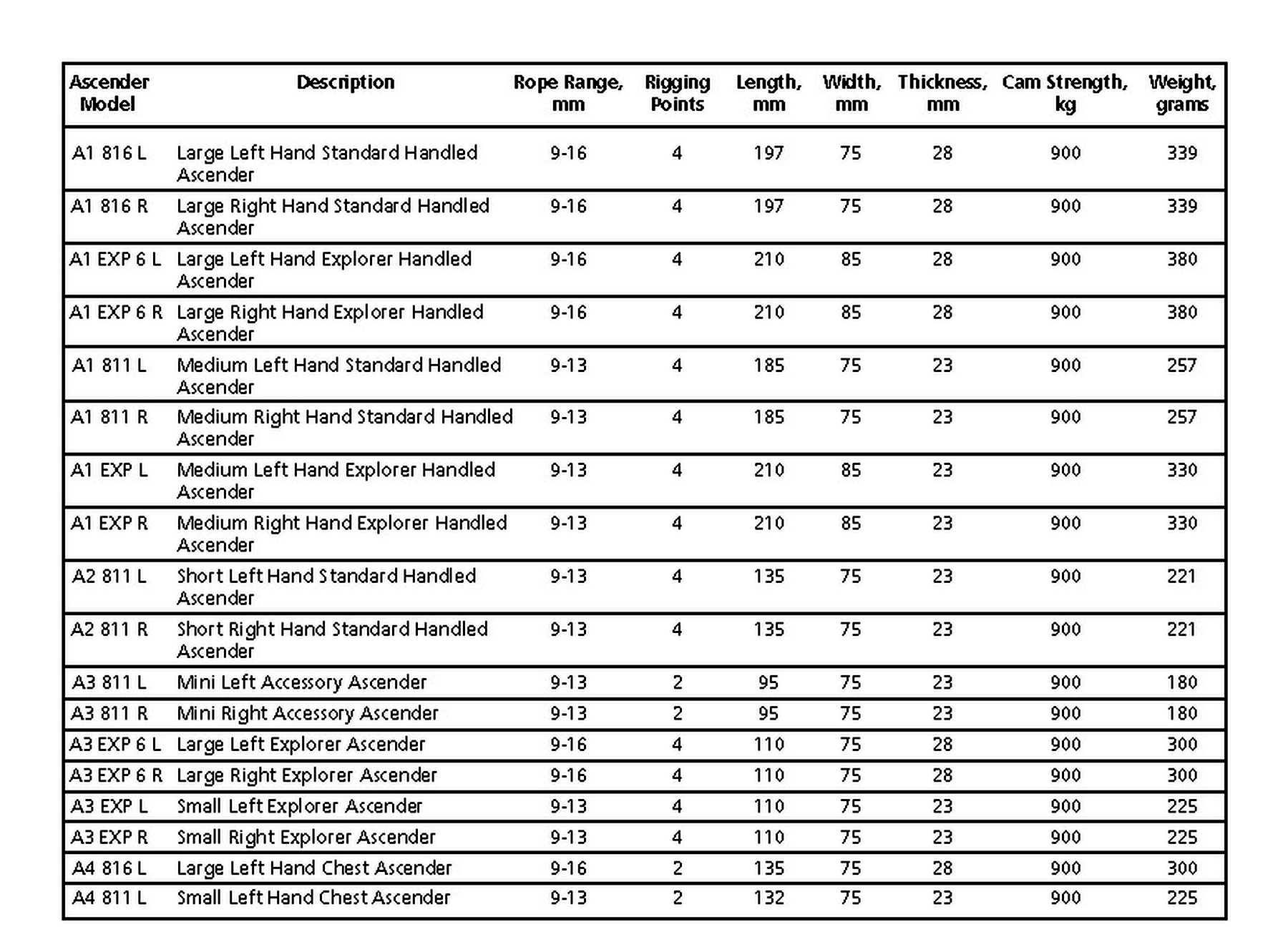Overview
History
Boris Rogelja founded Single Rope Technique Equipment (SRTE) in 1980. Capital Safety Group acquired SRTE in 2011 and their devices started showing DBI-SALA, Capital Safety, and/or Rollgliss™ markings. Some of these continued to show SRTE markings, and some did not. There does not appear to be a specific date when the markings disappeared. Different devices removed the SRTE logo at different times. 3M acquired the Capital Safety Group in 2015 and the Single Rope Technique Equipment markings disappeared completely.
[ Top
| A1 Explorer v. B
| A1 Explorer v. C
| A1 EXP 6 Explorer
| A1 EXP 6L & 6R
| Caver 8-11 mm
| Caver 8-16 mm
| Climber
| Return to H.E.C. Ascenders
]
A1 Explorer, Version A
(#54)
Technical Details
I acquired this pair of ascenders from Inner Mountain Outfitters
at the 1994 Speleofest.
The Single Rope Technique Equipment A1 Explorer, Version A is 206 mm. tall, 86 mm. wide, 31 mm. thick, and weighs 314 g.
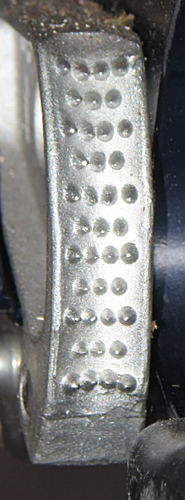 The shell is milled from the same extrusion as the Caver 8-11 mm.
Like the caver, the extrusion direction is oriented parallel to
the vertical axis of the ascender, and contains two opposing channels.
One channel is rounded and becomes the rope channel, the other
is square and holds the cam. The rope channel is 14 mm. wide. The construction is a refinement
of the Caver construction. The ascender has a more rounded shape,
and the handgrip is angled. A soft plastic grip with aluminum
insets is riveted to the frame. There are two holes at the bottom
of the frame. The larger hole has an aluminum inset that provides
a larger radius for slings to run over. The inside diameter of
the inset is 17 mm. The smaller hole is located farther from
the main line, and is only 12.8 mm. in diameter. The top
of the frame has a 16 mm. hole drilled through both sides
of the rope channel, and a 12.8 mm. hole above the cam pivot.
The rope channel does no protrude as far from the ascender body
as on the Caver.
The shell is milled from the same extrusion as the Caver 8-11 mm.
Like the caver, the extrusion direction is oriented parallel to
the vertical axis of the ascender, and contains two opposing channels.
One channel is rounded and becomes the rope channel, the other
is square and holds the cam. The rope channel is 14 mm. wide. The construction is a refinement
of the Caver construction. The ascender has a more rounded shape,
and the handgrip is angled. A soft plastic grip with aluminum
insets is riveted to the frame. There are two holes at the bottom
of the frame. The larger hole has an aluminum inset that provides
a larger radius for slings to run over. The inside diameter of
the inset is 17 mm. The smaller hole is located farther from
the main line, and is only 12.8 mm. in diameter. The top
of the frame has a 16 mm. hole drilled through both sides
of the rope channel, and a 12.8 mm. hole above the cam pivot.
The rope channel does no protrude as far from the ascender body
as on the Caver.
The cam is a plated skeletonized, reinforced stainless steel
casting with a (4.3)^5(4)(F) conical tooth pattern, where
the F is a flat spot below the teeth. The tooth axes
are perpendicular to the cam face. The cam radius increases from 46 to 62 mm. over an angle of 37°, giving a 25° cam angle. The cam, cam spring, and a cam
housing are mounted on a 6.4 mm. semi-tubular rivet. The cam housing
is a piece of thin sheet metal bent to cover the top of the cam
channel and serve as a spacer along the sides of the cam. The
top of the housing is indented; this limits cam closing so that
the teeth do not hit the inside of the rope channel. The cam safety
is a U-shaped piece of stainless steel mounted on a 3 mm.
stainless steel rivet placed through two tabs on the base of the
cam. A small thumb knob is staked to the safety. The knob is turned
to give a contoured grip. The safety is placed so that it does
not interfere with one’s hand in the handle.
The back of the frame is stamped with "AUSTRALIA,"
the SRT logo, and "PATENTED." An arrow, "UP," and
"SRT" are cast on each side of the cam. The aluminum
inset on the front side of the left grip and rear side on the right grip is marked with the SRT logo
and "EXPLORER." The opposite-side inset is marked "Ø
11mm AT CAM MAX 900kg."
The Explorer series is S.R.T’s premier line. One expects quality
form S.R.T., and once again they deliver. The sling attachment
holes are not beveled, but the aluminum inset in the main attachment
point provides adequate sling protection. The sling attachment
holes could theoretically have the same safety problem described
for the Clog ascender, so I don't recommend
using carabiners in them. There is one more upper sling attachment
hole than C.M.I. provides. Unfortunately,
the upper frame is still more difficult to grasp from above than
either the Jumar or the small C.M.I. UltrAscender.
This latter point is more important than the number of attachment
holes available.
The cam is very well made, reminiscent of Jumar’s.
I suspect that it is also quite strong. The comments provided
for the Caver apply here as well.
The ascender cam can be opened by either hand. The cam safety
can easily be operated with the thumb of the normal hand (right
hand for right-hand ascender), and the cam opened in one smooth
motion. Opening with the opposite hand is more difficult, but
can be done with the index finger. The safety is solid and much
better made than the one on the I.S.C. Big
Wall. The safety can be hooked over the cam channel to hold
the cam completely open. There is no partial cam hold open feature,
nor is one needed.
In general, this is a very well made, rugged ascender which
is suitable for a wide variety of uses.
[ Top
| A1 Explorer v. A
| A1 Explorer v. C
| A1 EXP 6 Explorer
| A1 EXP 6L & 6R
| Caver 8-11 mm
| Caver 8-16 mm
| Climber
| Return to H.E.C. Ascenders
]
A1 Explorer, Version B
(#2213)
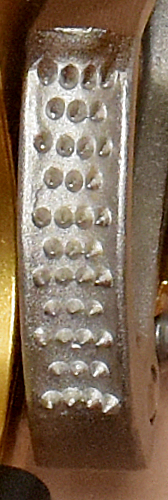 Technical Details
Technical Details
I acquired this ascender in 2017 as part of Bob Thrun’s collection.
The Single Rope Technique A1 Explorer, Version B is 210 mm. tall, 90 mm. wide, 34 mm. thick, and weighs 315 g.
Version B is mechanically identical to Version A. Only the color and markings differ.
The back of the frame is stamped with "AUSTRALIA,"
the SRT logo, and "PATENTED." An arrow, "UP," and
"SRT" are cast on each side of the cam. The aluminum
inset on the front side of the grip inset is marked "Ø
11mm AT CAM MAX 900kg." The inset on the rear is marked with the SRT logo
and "EXPLORER" running from top to bottom, as opposed to running from bottom to top on Version A.
Version B is functionally identical to Version A.
[ Top
| A1 Explorer v. A
| A1 Explorer v. B
| A1 EXP 6 Explorer
| A1 EXP 6L & 6R
| Caver 8-11 mm
| Caver 8-16 mm
| Climber
| Return to H.E.C. Ascenders
]
A1 Explorer, Version C
(#3483)
Technical Details
 I acquired this pair of ascenders from Inner Mountain Outfitters
at the 1994 Speleofest. I acquired another pair in 2017 as part of Bob Thrun’s collection.
I acquired this pair of ascenders from Inner Mountain Outfitters
at the 1994 Speleofest. I acquired another pair in 2017 as part of Bob Thrun’s collection.
The Single Rope Technique Equipment A1 Explorer is 206 mm. tall, 86 mm. wide, 31 mm. thick, and weighs 314 g.
The shell, hand grip, and grip inserts on Version C are the same as on Version A.
Version C uses the same cam as the A1 EXP 6 Explorer. The cam is a plated skeletonized, reinforced stainless steel
casting with a (4.3)^5(4)(F) conical tooth pattern, where
the F is a flat spot below the teeth. The tooth axes
are perpendicular to the cam face. The cam radius increases from 41 to 61 mm. over an angle of 41°, giving a 29° cam angle. The cam mounting, cam spring, cam
housing, and cam safety are the same as those on Version A.
The back of the frame is stamped with "AUSTRALIA,"
the SRT logo, and "PATENTED." An arrow, "UP," and
"SRT" are cast on each side of the cam. The aluminum
inset on the front side of the grip is marked with the SRT logo
and "EXPLORER." The inset on the rear is marked "Ø
11mm AT CAM MAX 900kg."
I don't know if Bob realized that the cams on his two gold-colored A1 Explorers were different, but knowing his attention to fine detail, he probably did. I was more careless, and did not notice the difference until later.
I don't notice any difference between the performance of the old and new tooth patterns.
[ Top
| A1 Explorer v. A
| A1 Explorer v. B
| A1 Explorer v. C
| A1 EXP 6L & 6R
| Caver 8-11 mm
| Caver 8-16 mm
| Climber
| Return to H.E.C. Ascenders
]
A1 EXP 6 Explorer
(#147)
Technical Details
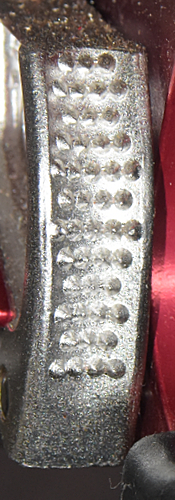 I acquired this pair of ascenders from Single Rope Technique Equipment
Equipment in 2000.
I acquired this pair of ascenders from Single Rope Technique Equipment
Equipment in 2000.
The Single Rope Technique Equipment A1 EXP 6 Large Explorer is 209 mm. tall, 88 mm. wide, 32 mm. thick, and weighs 352 g. The rope channel is 18 mm. wide. The cam radius increases from 41 to 61 mm. over an angle of 41°, giving a 29° cam angle. The tooth pattern is (3.4)^2(5.4)^2(3.4)^2(F), where
the F is a flat spot below the teeth.
This is a large Version of the A1 Explorer (now numbered
the A1 EXP) that can handle ropes ranging from 8 mm. to 16 mm
diameter. This ascender
is well-made, and ought to please to the "bigger is better" crowd, but I prefer the smaller version.
[ Top
| A1 Explorer v. A
| A1 Explorer v. B
| A1 Explorer v. C
| A1 EXP 6 Explorer
| Caver 8-11 mm
| Caver 8-16 mm
| Climber
| Return to H.E.C. Ascenders
]
Single Rope Technique Equipment/Rollgliss/DBI Sala
A1 EXP 6L & 6R
(#2217, 2218)
Technical Details
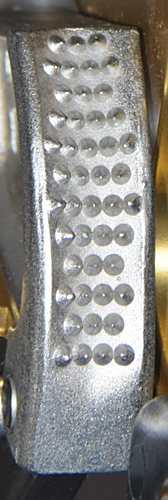 I acquired two pairs of Single Rope Technique Equipment/Rollgliss/DBI Sala A1 EXP 6L & 6R in 2017 as part of Bob Thrun’s collection.
I acquired two pairs of Single Rope Technique Equipment/Rollgliss/DBI Sala A1 EXP 6L & 6R in 2017 as part of Bob Thrun’s collection.
The Single Rope Technique Equipment/Rollgliss/DBI Sala A1 EXP 6L & 6R is 212 mm. tall, 88 mm. wide, 31 mm. thick, and weighs 386 g. The rope channel is 18 mm. wide. The cam radius increases from 41 to 59 mm. over an angle of 40°, giving a 28° cam angle. The tooth pattern is (3.4)^2(5.4)^2(3.4)^2(F), where
the F is a flat spot below the teeth.
The rear is printed with "CAPITAL SAFETY GROUP," the DBI-SALA logo, "www.capitalsafety.com," "Rollgliss®," "8700524," the SRTE logo, "Made under a quality scheme certified by SAI GLOBAL Lic SMKH25365," "MBS AT CAM 800kg," "Rope ¥ 10.5≤ Ø ≤ 13mm, the SAI GLobal certified product icon, a danger icon, "WARNING," "PROPER TRAINING IS ESSENTIAL," a book-with-an-"i" icon, "Lic SMKH25365," "CE 2056," "EN 12278," "AS/NZS 4488," "MEETS NFPA 1983 (2012 ED)T," "D.O.M. Sep 2012," AND "SERIAL # 201071-3." The cam has "SRT," "UP," and an up-pointing arrow cast in raised characters.
The Single Rope Technique Equipment/Rollgliss/DBI Sala A1 EXP 6L & 6R has minor changes to the frame shape and restores the metal inserts on the handles that were removed on the A1 EXP 6 Explorer.
The rear is printed with enough literature to keep your mind occupied while climbing the hawser anchoring your battleship.
[ Top
| A1 Explorer v. A
| A1 Explorer v. B
| A1 Explorer v. C
| A1 EXP 6 Explorer
| A1 EXP 6L & 6R
| Caver 8-16 mm
| Climber
| Return to H.E.C. Ascenders
]
Caver 8-11 mm
(#51, 2214, 2345)
Technical Details
I acquired this pair of ascenders from K.H.S. Sales at the
1988 Old Timers Reunion. I acquired another pair in 2017 as part of Bob Thrun’s collection, and a left-handed ascender from Bill Liebman at the 2017 Old Timers Reunion.
The Single Rope Technique Equipment Caver, 8-11 mm. is 185 mm. tall, 76 mm. wide, 25 mm. thick, and weighs 251 g.
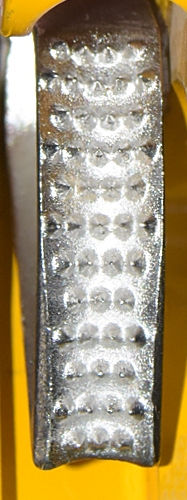 The shell is milled from a custom aluminum extrusion which
appears to be a direct copy of the C.M.I.
5000 extrusion. Like the C.M.I.,
the extrusion direction is oriented parallel to the vertical axis
of the ascender, and contains two opposing channels. One channel
is rounded and becomes the rope channel, the other is square
and holds the cam. The rope channel is 14 mm. wide. The manufacturing process is similar to C.M.I.’s, but the shape of the final ascender
varies somewhat. The hand hole is nearly rectangular rather than
sloped at the top, and the top of the frame is not sloped like
the C.M.I. 5000 . Two 15.6 mm. holes
are drilled at the bottom and a two more are drilled at the top
of the frame. The hand hole is made a little wider than on the
C.M.I. 5000, so the rope channel does
no protrude as far from the ascender body as on the C.M.I.
5000.
The shell is milled from a custom aluminum extrusion which
appears to be a direct copy of the C.M.I.
5000 extrusion. Like the C.M.I.,
the extrusion direction is oriented parallel to the vertical axis
of the ascender, and contains two opposing channels. One channel
is rounded and becomes the rope channel, the other is square
and holds the cam. The rope channel is 14 mm. wide. The manufacturing process is similar to C.M.I.’s, but the shape of the final ascender
varies somewhat. The hand hole is nearly rectangular rather than
sloped at the top, and the top of the frame is not sloped like
the C.M.I. 5000 . Two 15.6 mm. holes
are drilled at the bottom and a two more are drilled at the top
of the frame. The hand hole is made a little wider than on the
C.M.I. 5000, so the rope channel does
no protrude as far from the ascender body as on the C.M.I.
5000.
The cam is a plated skeletonized, reinforced stainless steel
casting with a (4.5)^3(4.3)^3 conical tooth count. The tooth axes
are perpendicular to the cam face. The cam radius increases from 40 to 58 mm. over an angle of 44°, giving a 26° cam angle. The cam, cam spring, and a cam
housing are mounted on a 6.4 mm. semi-tubular rivet. The cam housing
is a piece of thin sheet metal bent to cover the top of the cam
channel and serve as a spacer along the sides of the cam. The
top of the housing is indented; this limits cam closing so that
the teeth do not hit the inside of the rope channel. The cam safety
is a piece of green anodized aluminum mounted on a 4 mm.
stainless steel semi-tubular rivet located half way up the handle. A second
stainless steel pin provides a thumb grip on the safety. The ends
of this pin are well rounded. The safety is designed to sit almost
completely inside the cam/safety channel, so it does not interfere
with one’s hand in the handle.
The inside of the frame (behind the cam) is stamped "S.R.T,"
"AUSTRALIA," and "EQUIP" A kangaroo logo is
cast on each side of the cam.
The S.R.T. is a very well made ascender. I have not broken
an S.R.T. ascender, but the frame is undoubtedly very strong.
The sling attachment holes are nicely beveled. The sling attachment
holes could theoretically have the same safety problem described
for the Clog ascender, so I don't recommend
using carabiners in them. There is one more upper sling attachment
hole than C.M.I. provides. Unfortunately,
the upper frame is still more difficult to grasp from above than
either the Jumar or the small C.M.I. UltrAscender.
This latter point is more important than the number of attachment
holes available. Like the C.M.I.’s, the
main rope could get caught in the cam/safety channel, but I've
never seen this happen in practice.
The cam is very well made, reminiscent of Jumar’s.
I suspect that it is also quite strong. I'm not thrilled with
semi-tubular rivets for cam pivots, but at least the S.R.T.’s are not
cracked. S.R.T. should consider using a grooved pin and external
retaining ring similar to the C.M.I.
design. The cam housing is lightweight and crude, but it doesn't
serve any critical function so I'm not too concerned with its
design. It may even be possible to eliminate the cam housing completely
and substitute two washers, or even widen the cam a bit and eliminate
them too. The main drawback is that the cam housing helps keep
mud out of the cam pivot, and eliminating the housing might cause
the ascender to jam more easily in muddy conditions.
The cam safety is designed to be out of the way, so it is a
little more difficult to operate than the Jumar’s,
but not by much. The ascender is still easily operated by either
hand. I like having metal cam safeties like the S.R.T.’s. I've
seen too many broken plastic ones on other ascenders to enjoy
that technological "improvement." There is no partial
cam hold open feature, nor is one needed. The safety design does
allow holding the cam in the full open position if desired.
In general, this is a very well made, rugged ascender which
is suitable for a wide variety of uses.
[ Top
| A1 Explorer v. A
| A1 Explorer v. B
| A1 Explorer v. C
| A1 EXP 6 Explorer
| A1 EXP 6L & 6R
| Caver 8-11 mm
| Climber
| Return to H.E.C. Ascenders
]
Caver 8-16 mm
(#52, 53, 2216)
Technical Details
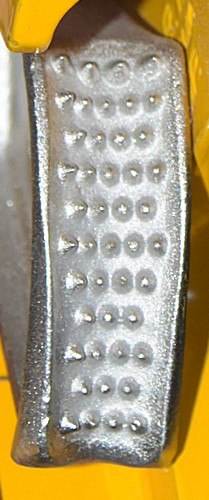 I acquired a left-hand ascender from J. E. Weinel, Inc. in
June 1989, and a right-hand ascender from Single Rope Technique Equipments
in October 1989. I acquired another pair in 2017 as part of Bob Thrun’s collection.
I acquired a left-hand ascender from J. E. Weinel, Inc. in
June 1989, and a right-hand ascender from Single Rope Technique Equipments
in October 1989. I acquired another pair in 2017 as part of Bob Thrun’s collection.
The Single Rope Technique Equipment Caver, 8-16mm is 196 mm. tall, 80 mm. wide, 31 mm. thick, and weighs 340 g. The rope channel is 18 mm. wide. The cam radius increases from 38 to 56 mm. over an angle of 43°, giving a 28° cam angle. The tooth pattern is (4.5)^3(4.3)^2(4).
This is a larger version of the preceding model. It is
designed for ropes up to 16 mm. in diameter. The frame is
larger and the cam, cam housing, and cam safety are wider. The
cam tooth count is reduced to (4.5)^3(4.3)^2(4), and the teeth
are not nearly as well formed as in the smaller model.
My comments on the preceding model apply to this one too.
This ascender is more appropriate if you anticipate needing to
climb ropes larger than about 13 mm., but the price paid
is an increase in weight and bulk. This should please the "bigger is better"
crowd and few others.
[ Top
| A1 Explorer v. A
| A1 Explorer v. B
| A1 Explorer v. C
| A1 EXP 6 Explorer
| A1 EXP 6L & 6R
| Caver 8-11 mm
| Caver 8-16 mm
| Return to H.E.C. Ascenders
]
Climber
(#50, 2215)
Technical Details
 I acquired this pair of ascenders from Inner Mountain Outfitters
at the 1988 Old Timers Reunion. I acquired another pair in 2017 as part of Bob Thrun’s collection.
I acquired this pair of ascenders from Inner Mountain Outfitters
at the 1988 Old Timers Reunion. I acquired another pair in 2017 as part of Bob Thrun’s collection.
This ascender is a shortened Version of the Caver Version A.
The only significant difference is in the frame, which has been
shortened by about 50 mm. The cam safety on mine is red instead
of green, and a punch was made to help hold the thumb pin in place.
Once again, most of the comments on the Caver Version A
apply here. This ascender is very well made. The small size makes
it a desirable alternative handled ascender to the full size ascenders
in many situations. In those cases the S.R.T. Climber and the
C.M.I. small UltrAscender are the two
options available. The C.M.I. small UltrAscender
is smaller and lighter, but the S.R.T. has a better safety design.
The C.M.I. is easier to grasp from above
The C.M.I. has a larger handle opening,
but the sling must go through that opening. The C.M.I.
cam is easier to replace, but the paint on the S.R.T. is more
durable. In short, there are a number of things to consider. Although
I prefer the C.M.I. (particularly after
making some modifications to the safety), the decision boils down
to personal preference; either one is acceptable. I choose the
C.M.I., but one of my partners, after
borrowing part of my collection to try, chose the S.R.T.
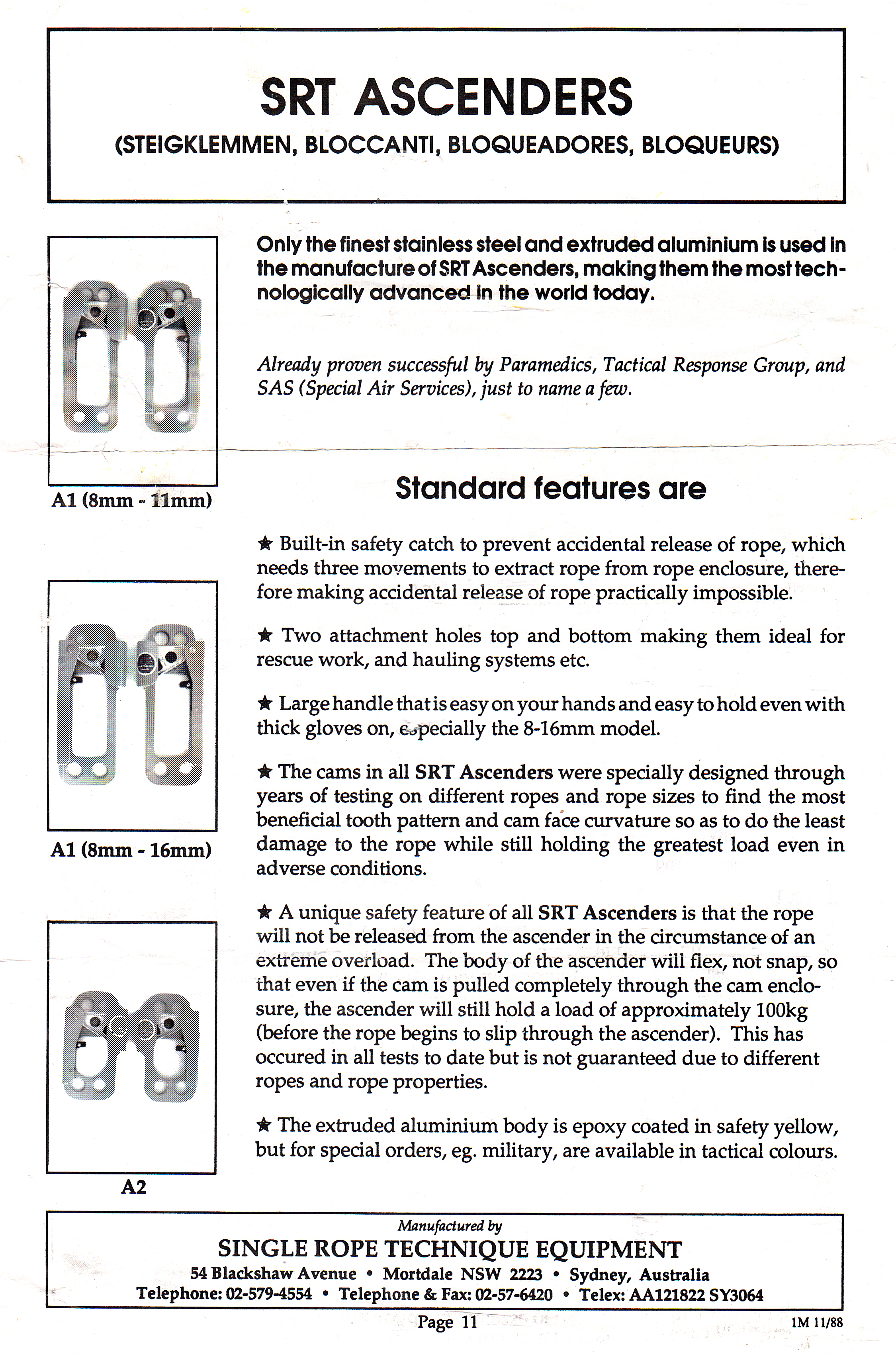 |
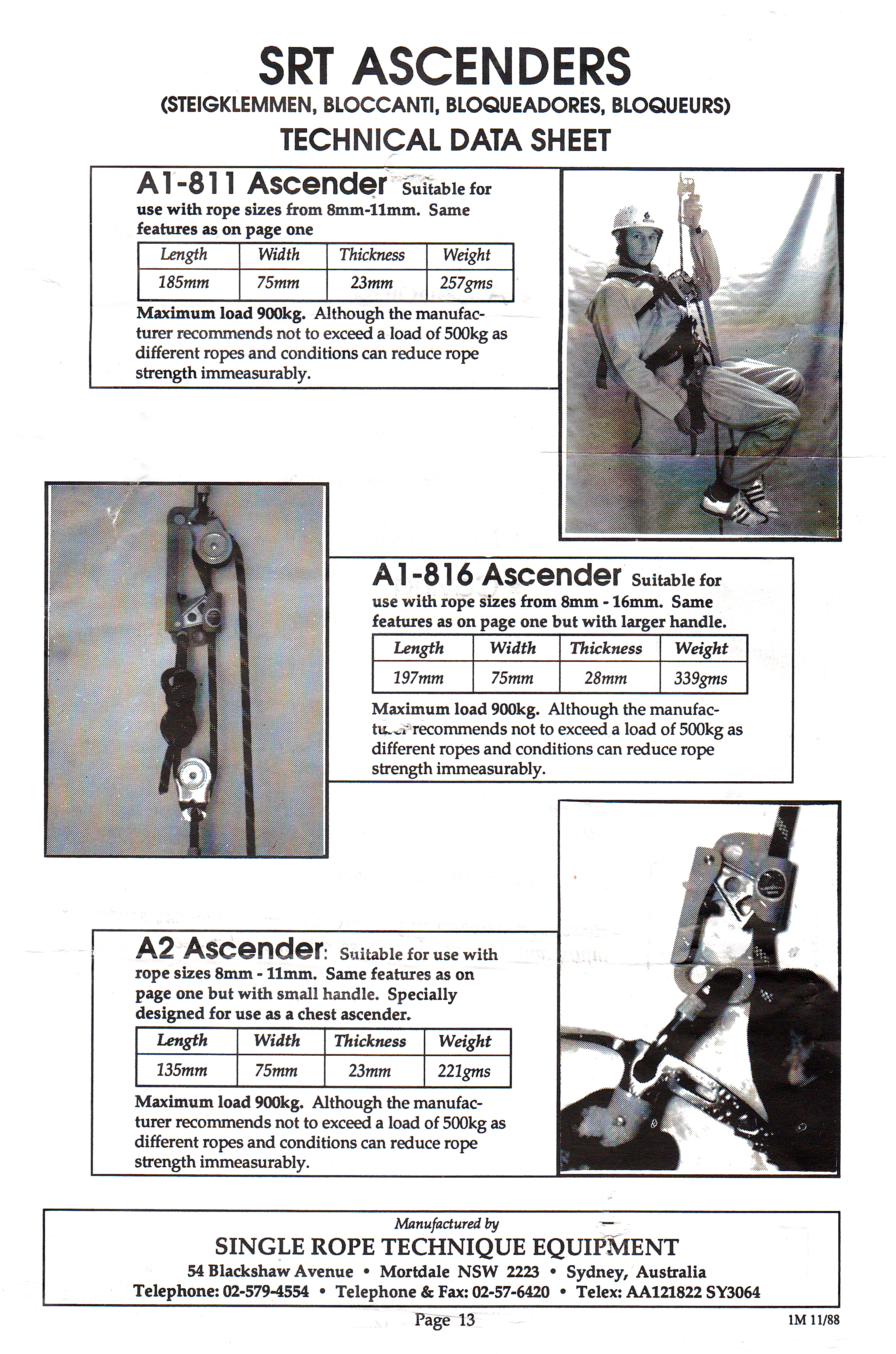 |
[ Top
| A1 Explorer v. A
| A1 Explorer v. B
| A1 Explorer v. C
| A1 EXP 6 Explorer
| A1 EXP 6L & 6R
| Caver 8-11 mm
| Caver 8-16 mm
| Climber
]



